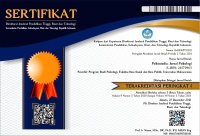Emotional Exhaustion among Child Protection Workers in Indonesia
Abstract
The government through the Ministry of Women's Empowerment and Child Protection (MOWECP) has a mandate to provide the best service for handling cases of violence against children. In providing these services, child protection workers indirectly make a significant contribution in helping children avoid worse impacts. However, these child protection workers are also a group that is at risk of experiencing emotional exhaustion in their work. This study was conducted to explore the experience of emotional exhaustion felt by child protection workers in dealing with cases of violence against children and how they cope with it. This study uses a qualitative method with a phenomenological approach. Data were collected through semi-structured interviews with 4 samples of child protection workers consisting of Clinical Psychologist, Counselor, Social Worker and Advocate. The data was then analyzed using thematic analysis and revealed 4 main themes i.e. child protection workers experiencing various forms of exhaustion which are physical, emotional and mental; factors that influence the state of emotional exhaustion; child protection workers believe that their work is beneficial; and child protection workers use various ways to cope with work-related emotional exhaustion. The results of this study suggest MOWECP to complete the work system in the child protection service and provide self-care facilities for child protection workers. It is recommended that a similar study be conducted at Unit Pelayanan Teknis Daerah Perlindungan Perempuan dan Anak (PPA) dan and involve child protection workers with civil servant status.
Pemerintah melalui Kementerian Pemberdayaan Perempuan dan Perlindungan Anak (KemenPPPA) mendapatkan mandat untuk memberikan pelayanan terbaik bagi penanganan kasus kekerasan terhadap anak. Dalam pemberian layanan tersebut, petugas layanan secara tidak langsung memberi kontribusi yang cukup besar dalam membantu anak terhindar dari dampak yang lebih buruk. Akan tetapi, petugas layanan tersebut juga menjadi kelompok yang riskan mengalami kelelahan emosional di dalam pekerjaannya. Penelitian ini dilakukan untuk menggali pengalaman kelelahan emosional yang dirasakan petugas perlindungan anak dalam menangani kasus-kasus kekerasan terhadap anak dan bagaimana mereka mengatasi hal tersebut. Penelitian ini menggunakan metode kualitatif dengan pendekatan fenomenologi. Data dikumpulkan melalui wawancara semi terstruktur terhadap 4 sampel petugas layanan perlindungan anak yang terdiri dari Psikolog Klinis, Konselor, Pekerja Sosial dan Advokat. Data wawancara ini kemudian dianalisis menggunakan analisis tematik sehingga menghasilkan 4 tema utama yaitu petugas layanan perlindungan anak mengalami bentuk kelelahan yang beragam baik fisik, emosi dan mental; faktor-faktor yang mempengaruhi keadaan kelelahan emosional; petugas layanan perlindungan anak meyakini bahwa pekerjaannya memberikan manfaat; dan petugas layanan perlindungan anak menggunakan berbagai cara untuk mengatasi kelelahan emosional terkait pekerjaan. Hasil penelitian ini menyarankan KemenPPPA untuk merampungkan sistem kerja di layanan perlindungan anak dan menyediakan fasilitas self-care bagi petugas layanan. Penelitian serupa disarankan untuk dilakukan di Unit Pelayanan Teknis Daerah Perlindungan Perempuan dan Anak (PPA) dan melibatkan petugas layanan yang berstatus pegawai negeri sipil.
Keywords
Full Text:
FULL TEXTReferences
Adnan Bintang, & Sita Rositawati. (2022). Studi Deskriptif Brunout pada Guru yang Melaksanakan Pembelajaran Jarak Jauh. Bandung Conference Series: Psychology Science, 2(1). https://doi.org/10.29313/bcsps.v2i1.349
Ahsyari, E. R. N. (2014). Kelelahan Emosional dan Strategi Coping Pada Wanita Single Parent (Studi Kasus Single Parent di Kabupaten Paser). Psikoborneo: Jurnal Ilmiah Psikologi, 2(3), 170–176. https://doi.org/10.30872/psikoborneo.v2i3.3659
Anderson, D. G. (2000). Coping strategies and burnout among veteran child protection workers. Child Abuse & Neglect, 24(6), 839–848. https://doi.org/10.1016/S0145-2134(00)00143-5
Braun, V., & Clarke, V. (2006). Using thematic analysis in psychology. Qualitative Research in Psychology, 3(2), 77–101. https://doi.org/10.1191/1478088706qp063oa
Bunting, L., & Bhatti‐Sinclair, K. (2022). Editorial. Child Abuse Review, 31(5). https://doi.org/10.1002/car.2788
Carr, A., Duff, H., & Craddock, F. (2020). A Systematic Review of Reviews of the Outcome of Noninstitutional Child Maltreatment. Trauma, Violence, & Abuse, 21(4), 828–843. https://doi.org/10.1177/1524838018801334
Creswell, J. (2013). Qualitative Inquiry & Research Design: Choosing Among Five Approaches. SAGE Publications, 11.
DeJonckheere, M., & Vaughn, L. M. (2019). Semistructured interviewing in primary care research: a balance of relationship and rigour. Family Medicine and Community Health, 7(2), e000057. https://doi.org/10.1136/fmch-2018-000057
Dhamayanti, M., Noviandhari, A., Masdiani, N., Pandia, V., & Sekarwana, N. (2020). The association of depression with child abuse among Indonesian adolescents. BMC Pediatrics, 20(1), 313. https://doi.org/10.1186/s12887-020-02218-2
Eastwood, C. D., & Ecklund, K. (2008). Compassion Fatigue Risk and Self-Care Practices Among Residential Treatment Center Childcare Workers. Residential Treatment for Children & Youth, 25(2), 103–122. https://doi.org/10.1080/08865710802309972
Edwards, F., & Wildeman, C. (2018). Characteristics of the front-line child welfare workforce. Children and Youth Services Review, 89, 13–26. https://doi.org/10.1016/j.childyouth.2018.04.013
Fang, X., Brown, D. S., Florence, C. S., & Mercy, J. A. (2012). The economic burden of child maltreatment in the United States and implications for prevention. Child Abuse & Neglect, 36(2), 156–165. https://doi.org/10.1016/j.chiabu.2011.10.006
Geoffrion, S., Morselli, C., & Guay, S. (2016). Rethinking Compassion Fatigue Through the Lens of Professional Identity. Trauma, Violence, & Abuse, 17(3), 270–283. https://doi.org/10.1177/1524838015584362
Holt, S., Buckley, H., & Whelan, S. (2008). The impact of exposure to domestic violence on children and young people: A review of the literature. Child Abuse & Neglect, 32(8), 797–810. https://doi.org/10.1016/j.chiabu.2008.02.004
Kapoulitsas, M., & Corcoran, T. (2015). Compassion fatigue and resilience: A qualitative analysis of social work practice. Qualitative Social Work, 14(1), 86–101. https://doi.org/10.1177/1473325014528526
Killian, K. D. (2008). Helping till it hurts? A multimethod study of compassion fatigue, burnout, and self-care in clinicians working with trauma survivors. Traumatology, 14(2), 32–44. https://doi.org/10.1177/1534765608319083
Kim, H., Ji, J., & Kao, D. (2011). Burnout and Physical Health among Social Workers: A Three-Year Longitudinal Study. Social Work, 56(3), 258–268. https://doi.org/10.1093/sw/56.3.258
Klusmann, U., Aldrup, K., Schmidt, J., & Lüdtke, O. (2021). Is emotional exhaustion only the result of work experiences? A diary study on daily hassles and uplifts in different life domains. Anxiety, Stress, & Coping, 34(2), 173–190. https://doi.org/10.1080/10615806.2020.1845430
Kresnicka, L. S. (2007). Legal Issues. In Comprehensive Pediatric Hospital Medicine (pp. 1100–1103). Elsevier. https://doi.org/10.1016/B978-032303004-5.50181-2
Lee, R. T., Seo, B., Hladkyj, S., Lovell, B. L., & Schwartzmann, L. (2013). Correlates of physician burnout across regions and specialties: a meta-analysis. Human Resources for Health, 11(1), 48. https://doi.org/10.1186/1478-4491-11-48
Leeb, R. T., Lewis, T., & Zolotor, A. J. (2011). A Review of Physical and Mental Health Consequences of Child Abuse and Neglect and Implications for Practice. American Journal of Lifestyle Medicine, 5(5), 454–468. https://doi.org/10.1177/1559827611410266
Lewig, Kerry;Sara, M. (2021). Caring for our frontline child protection workforce. Child Family Community Australia, 42.
Maslach, C., Schaufeli, W. B., & Leiter, M. P. (2001). Job Burnout. Annual Review of Psychology, 52(1), 397–422. https://doi.org/10.1146/annurev.psych.52.1.397
McFadden, P., Mallett, J., & Leiter, M. (2018). Extending the two‐process model of burnout in child protection workers: The role of resilience in mediating burnout via organizational factors of control, values, fairness, reward, workload, and community relationships. Stress and Health, 34(1), 72–83. https://doi.org/10.1002/smi.2763
Mondragon, I. (2021). Emotional Exhaustion Among Child Welfare Social Workers in Emotional Exhaustion Among Child Welfare Social Workers in Southern California: A Qualitative Study Southern California: A Qualitative Study. https://scholarworks.lib.csusb.edu/etd
No Title. (n.d.-a). www.jdih.kemenpppa.go.id
No Title. (n.d.-b). https://kekerasan.kemenpppa.go.id/
Olsvik, B. S., & Saus, M. (2022). Coping with Paradoxes: Norwegian Child Welfare Leaders Managing Complexity. Child Care in Practice, 28(3), 464–481. https://doi.org/10.1080/13575279.2020.1776683
Riany. (2022). Profil Anak Tahun 2022. In KemenPPPA. https://www.kemenpppa.go.id/index.php/page/read/38/4429/profil-anak-indonesia-2022
Rochelle, S., & Buonanno, L. (2018). Charting the attitudes of county child protection staff in a post-crisis environment. Children and Youth Services Review, 86, 166–175. https://doi.org/10.1016/j.childyouth.2018.01.032
Shin, S. H., Miller, D. P., & Teicher, M. H. (2013). Exposure to childhood neglect and physical abuse and developmental trajectories of heavy episodic drinking from early adolescence into young adulthood. Drug and Alcohol Dependence, 127(1–3), 31–38. https://doi.org/10.1016/j.drugalcdep.2012.06.005
Stalker, C. A., Mandell, D., Frensch, K. M., Harvey, C., & Wright, M. (2007). Child welfare workers who are exhausted yet satisfied with their jobs: how do they do it? Child & Family Social Work, 12(2), 182–191. https://doi.org/10.1111/j.1365-2206.2006.00472.x
Stanley, L. H. K., Lutz, S., Sabuncu, B. C., Magruder, L., & Wilke, D. J. (2023). Child welfare workers’ self-care activities and impacts on health and well-being. Journal of Workplace Behavioral Health, 1–22. https://doi.org/10.1080/15555240.2023.2274075
Stratton, S. J. (2021). Population Research: Convenience Sampling Strategies. Prehospital and Disaster Medicine, 36(4), 373–374. https://doi.org/10.1017/S1049023X21000649
Trujillo, K. C., Bruce, L., de Guzman, A., Wilcox, C., Melnyk, A., & Clark, K. (2020). Preparing the child welfare workforce: Organizational commitment, identity, and desire to stay. Child Abuse & Neglect, 110, 104539. https://doi.org/10.1016/j.chiabu.2020.104539
Yusuf, B. T. (2016). Studi Deskriptif Mengenai Burnout Pada Perawat Di Rumah Sakit Umum Daerah Soreang Kab. Bandung. 36. http://repository.unisba.ac.id:8080/handle/123456789/4526
DOI: http://dx.doi.org/10.30872/psikostudia.v13i2.14275
Refbacks
- There are currently no refbacks.
Copyright (c) 2024 Lydia Agnes Gultom & Zainal Abidin

This work is licensed under a Creative Commons Attribution-ShareAlike 4.0 International License.
Psikostudia: Jurnal Psikologi is indexed by :
PSIKOSTUDIA: Jurnal Psikologi Published by Faculty of Social and Political Siences, University of Mulawarman, Samarinda, East Kalimantan and This work is licensed under a Creative Commons Attribution-ShareAlike 4.0 International License.
_________________________________________
PSIKOSTUDIA: Jurnal Psikologi
Department of Psychology
Faculty of Social and Political Siences, University of Mulawarman
Jl. Muara Muntai Kampus Gn. Kelua Samarinda 75411
Phone: +62 813 35350368
E-Mail: psikostudia@fisip.unmul.ac.id




















